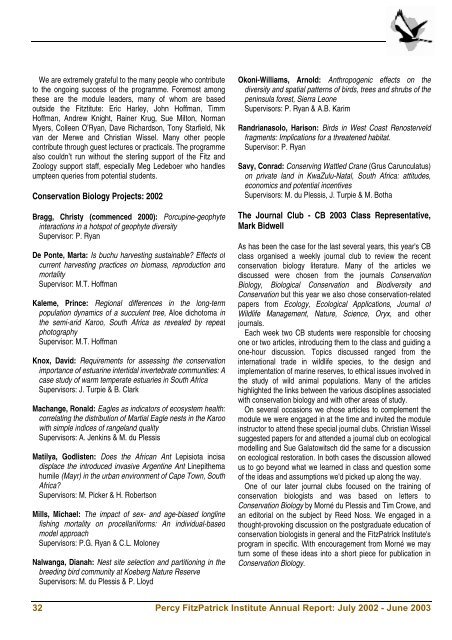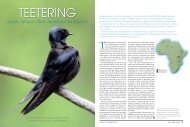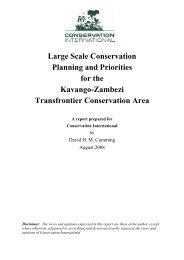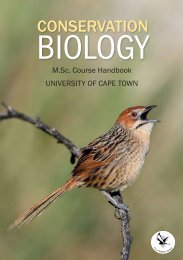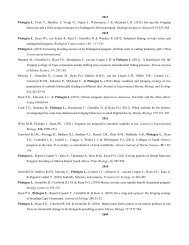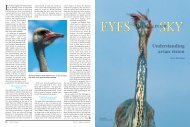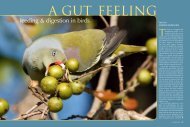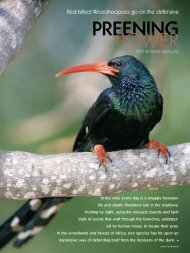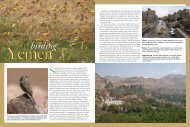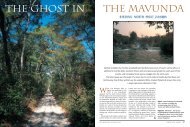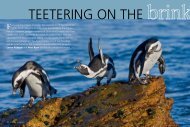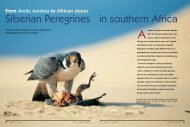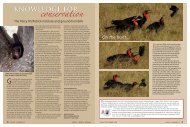Index of /depts/fitzpatrick/docs - Percy FitzPatrick Institute of African ...
Index of /depts/fitzpatrick/docs - Percy FitzPatrick Institute of African ...
Index of /depts/fitzpatrick/docs - Percy FitzPatrick Institute of African ...
Create successful ePaper yourself
Turn your PDF publications into a flip-book with our unique Google optimized e-Paper software.
We are extremely grateful to the many people who contributeto the ongoing success <strong>of</strong> the programme. Foremost amongthese are the module leaders, many <strong>of</strong> whom are basedoutside the Fitztitute: Eric Harley, John H<strong>of</strong>fman, TimmH<strong>of</strong>fman, Andrew Knight, Rainer Krug, Sue Milton, NormanMyers, Colleen O’Ryan, Dave Richardson, Tony Starfield, Nikvan der Merwe and Christian Wissel. Many other peoplecontribute through guest lectures or practicals. The programmealso couldn’t run without the sterling support <strong>of</strong> the Fitz andZoology support staff, especially Meg Ledeboer who handlesumpteen queries from potential students.Conservation Biology Projects: 2002Bragg, Christy (commenced 2000): Porcupine-geophyteinteractions in a hotspot <strong>of</strong> geophyte diversitySupervisor: P. RyanDe Ponte, Marta: Is buchu harvesting sustainable? Effects <strong>of</strong>current harvesting practices on biomass, reproduction andmortalitySupervisor: M.T. H<strong>of</strong>fmanKaleme, Prince: Regional differences in the long-termpopulation dynamics <strong>of</strong> a succulent tree, Aloe dichotoma inthe semi-arid Karoo, South Africa as revealed by repeatphotographySupervisor: M.T. H<strong>of</strong>fmanKnox, David: Requirements for assessing the conservationimportance <strong>of</strong> estuarine intertidal invertebrate communities: Acase study <strong>of</strong> warm temperate estuaries in South AfricaSupervisors: J. Turpie & B. ClarkMachange, Ronald: Eagles as indicators <strong>of</strong> ecosystem health:correlating the distribution <strong>of</strong> Martial Eagle nests in the Karoowith simple indices <strong>of</strong> rangeland qualitySupervisors: A. Jenkins & M. du PlessisMatilya, Godlisten: Does the <strong>African</strong> Ant Lepisiota incisadisplace the introduced invasive Argentine Ant Linepithemahumile (Mayr) in the urban environment <strong>of</strong> Cape Town, SouthAfrica?Supervisors: M. Picker & H. RobertsonMills, Michael: The impact <strong>of</strong> sex- and age-biased longlinefishing mortality on procellariiforms: An individual-basedmodel approachSupervisors: P.G. Ryan & C.L. MoloneyNalwanga, Dianah: Nest site selection and partitioning in thebreeding bird community at Koeberg Nature ReserveSupervisors: M. du Plessis & P. LloydOkoni-Williams, Arnold: Anthropogenic effects on thediversity and spatial patterns <strong>of</strong> birds, trees and shrubs <strong>of</strong> thepeninsula forest, Sierra LeoneSupervisors: P. Ryan & A.B. KarimRandrianasolo, Harison: Birds in West Coast Renosterveldfragments: Implications for a threatened habitat.Supervisor: P. RyanSavy, Conrad: Conserving Wattled Crane (Grus Carunculatus)on private land in KwaZulu-Natal, South Africa: attitudes,economics and potential incentivesSupervisors: M. du Plessis, J. Turpie & M. BothaThe Journal Club - CB 2003 Class Representative,Mark BidwellAs has been the case for the last several years, this year's CBclass organised a weekly journal club to review the recentconservation biology literature. Many <strong>of</strong> the articles wediscussed were chosen from the journals ConservationBiology, Biological Conservation and Biodiversity andConservation but this year we also chose conservation-relatedpapers from Ecology, Ecological Applications, Journal <strong>of</strong>Wildlife Management, Nature, Science, Oryx, and otherjournals.Each week two CB students were responsible for choosingone or two articles, introducing them to the class and guiding aone-hour discussion. Topics discussed ranged from theinternational trade in wildlife species, to the design andimplementation <strong>of</strong> marine reserves, to ethical issues involved inthe study <strong>of</strong> wild animal populations. Many <strong>of</strong> the articleshighlighted the links between the various disciplines associatedwith conservation biology and with other areas <strong>of</strong> study.On several occasions we chose articles to complement themodule we were engaged in at the time and invited the moduleinstructor to attend these special journal clubs. Christian Wisselsuggested papers for and attended a journal club on ecologicalmodelling and Sue Galatowitsch did the same for a discussionon ecological restoration. In both cases the discussion allowedus to go beyond what we learned in class and question some<strong>of</strong> the ideas and assumptions we'd picked up along the way.One <strong>of</strong> our later journal clubs focused on the training <strong>of</strong>conservation biologists and was based on letters toConservation Biology by Morné du Plessis and Tim Crowe, andan editorial on the subject by Reed Noss. We engaged in athought-provoking discussion on the postgraduate education <strong>of</strong>conservation biologists in general and the <strong>FitzPatrick</strong> <strong>Institute</strong>'sprogram in specific. With encouragement from Morné we mayturn some <strong>of</strong> these ideas into a short piece for publication inConservation Biology.32 <strong>Percy</strong> <strong>FitzPatrick</strong> <strong>Institute</strong> Annual Report: July 2002 - June 2003


